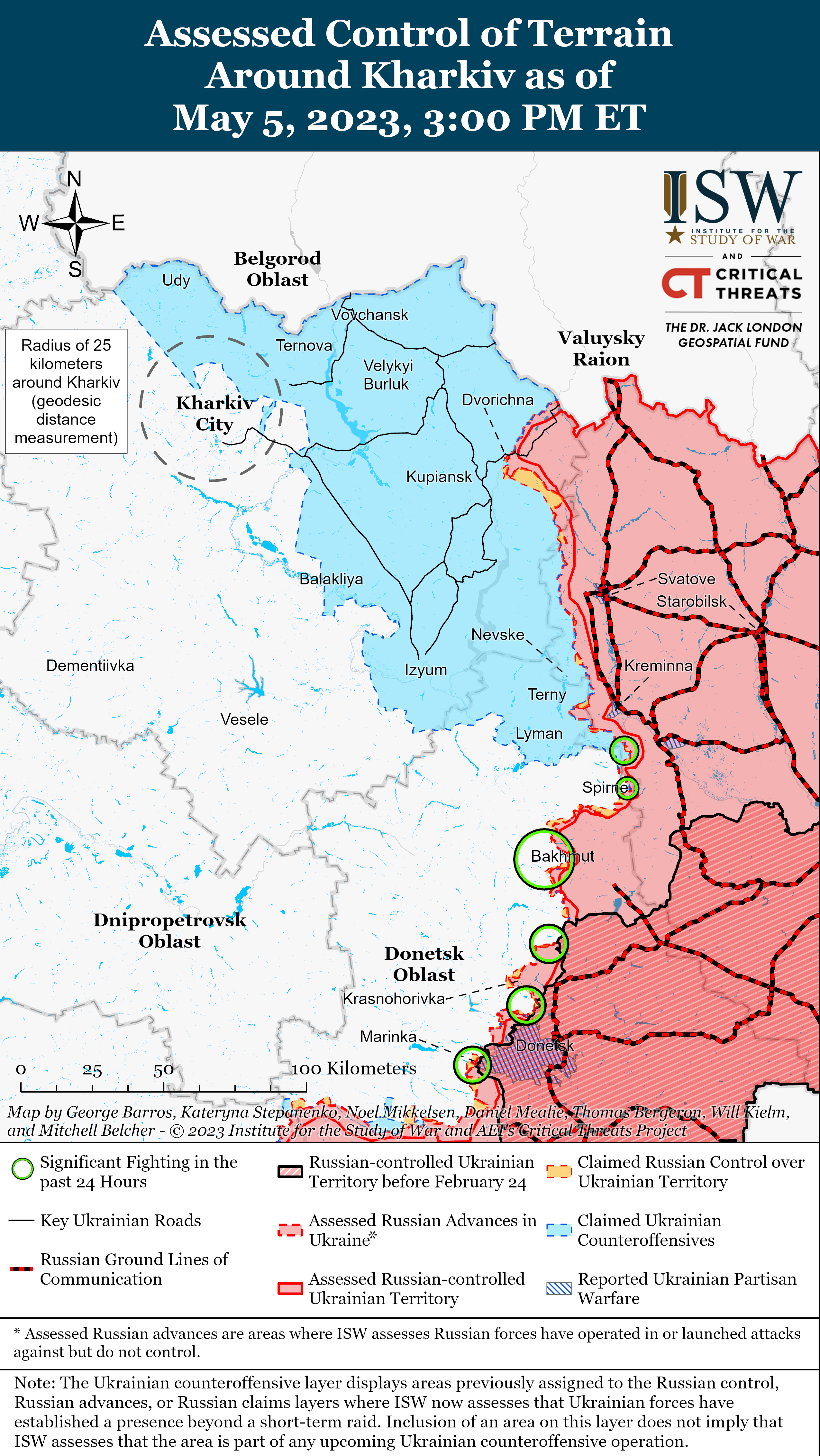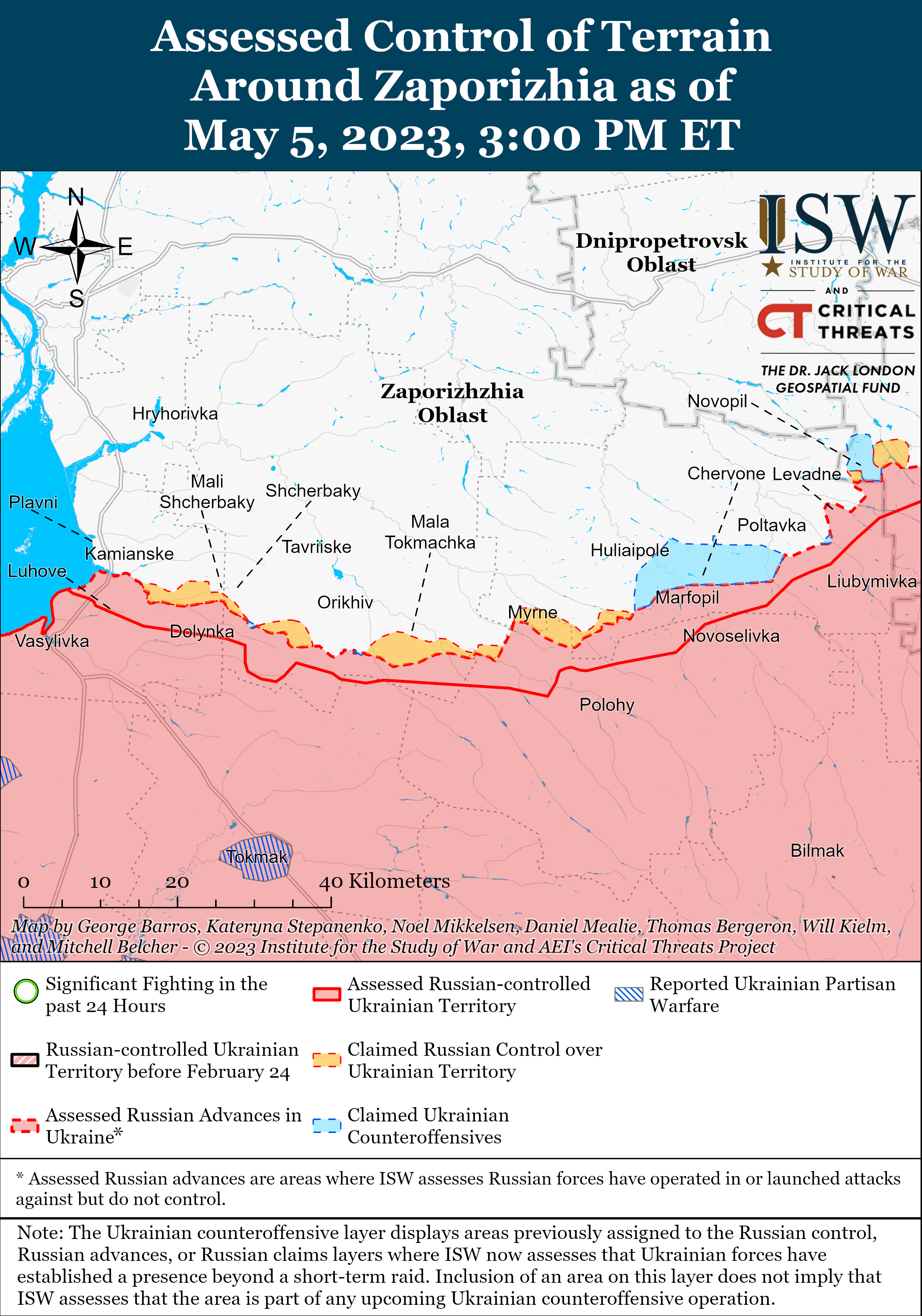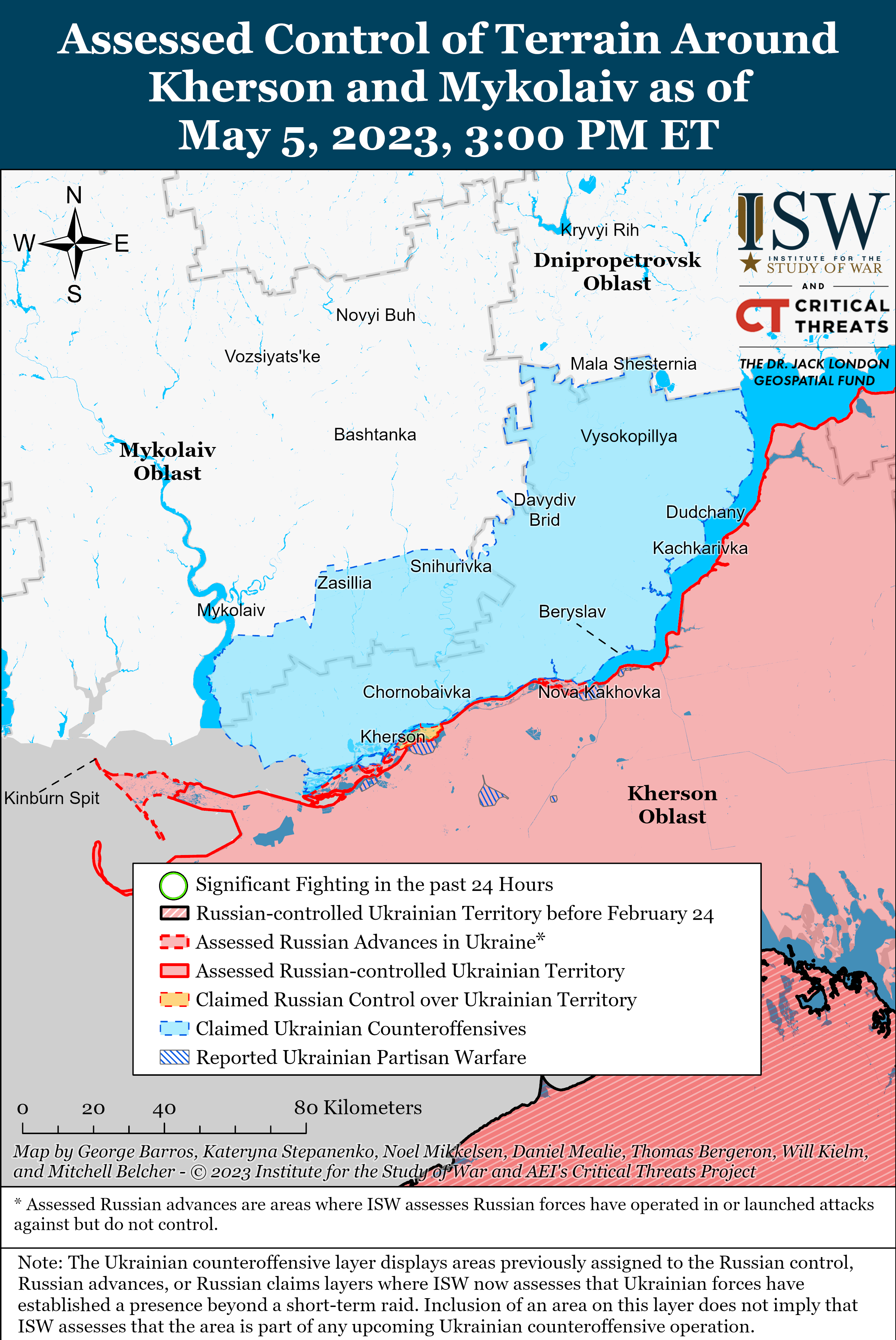 |
 |
Russian Offensive Campaign Assessment, May 5, 2023

Russian Offensive Campaign Assessment, May 5, 2023
Karolina Hird, Riley Bailey, Nicole Wolkov, Grace Mappes, Layne Philipson, and Frederick W. Kagan
May 5, 2023, 6pm ET
Click here to see ISW’s interactive map of the Russian invasion of Ukraine. This map is updated daily alongside the static maps present in this report.
Click here to access ISW’s archive of interactive time-lapse maps of the Russian invasion of Ukraine. These maps complement the static control-of-terrain map that ISW produces daily by showing a dynamic frontline. ISW will update this time-lapse map archive monthly.
The Russian Ministry of Defense (MoD) appears to have deprioritized the Bakhmut offensive in favor of preparing to defend against an anticipated Ukrainian counteroffensive, putting the Wagner Group and Wagner financier Yevgeny Prigozhin in a potentially difficult position. Prigozhin released a series of videos on May 4 and 5 announcing that Wagner will withdraw from Bakhmut on May 10 unless Wagner receives necessary supplies and launched particularly acerbic and emotional attacks against Chief of the Russian General Staff Army General Valery Gerasimov, Russian Minister of Defense Sergei Shoigu, and the Russian MoD establishment writ large.[1] Prigozhin’s palpable desperation in the videos, one of which shows the corpses of recently deceased Wagner fighters, marks a significant rhetorical inflection in his continued pleas for increased Russian MoD support for Wagner in Bakhmut. His visible and visceral anger suggests that the Russian MoD has likely deprioritized Bakhmut and shifted operational focus elsewhere in the theater in ways that may seriously compromise Wagner’s ability to operate effectively. Wagner has not ceased efforts to completely capture Bakhmut despite reduced access to ammunition and other necessary supplies, however. Prigozhin has shown no willingness to switch to the defensive within the city.
Wagner’s continued persistence within Bakhmut is incongruent with the overall slow-down in the pace of Russian offensive operations elsewhere in Ukraine as conventional Russian forces appear to be largely shifting focus to prepare to receive the much-anticipated Ukrainian counteroffensive.[2] Aside from very limited and localized attacks in the Kreminna area and near Donetsk City, Russian forces have largely ceased offensive operations throughout the theater, likely signifying a transition to the defensive.[3] It would be an operationally sound decision for the Russian MoD to begin withholding and stockpiling ammunition and supplies in order to prepare for any Ukrainian counteroffensive actions, and Prigozhin’s desperate statements indicate that the Russian MoD is likely doing so. ISW has recently reported that Prigozhin began appealing to the Russian MoD to provide Wagner with necessary ammunition once again after a brief period during which it seemed that relations between Prigozhin and Russian military leadership had improved.[4] Prigozhin’s renewed anger reached its peak in the May 4 video of Prigozhin essentially screaming at Gerasimov and Shoigu and accusing them of the deaths of Wagner fighters.[5]
The losses suffered by Wagner in Bakhmut, alongside the likely de-prioritization of the Bakhmut effort by the Russian MoD, may leave Prigozhin and Wagner in a particularly bad spot. It is not immediately clear whether Prigozhin actually intends to withdraw from Bakhmut on May 10 or whether he made the announcement in a last-ditch attempt to secure MoD support. If Wagner does withdraw, then it will likely need Russian MoD equipment to protect and facilitate the retrograde. The Russian military lacks the reserves needed to man positions Wagner might abandon in Bakhmut, moreover. The massive losses suffered by Wagner in Bakhmut for the sake of tactical gains, as well as the overall shift of the Russian military towards a more cautious posture preparing for defensive operations, appears to be offering Ukrainian forces opportunities for fruitful counterattacks in various areas of the front. Ukrainian forces appear to be seizing some of these opportunities, as noted below, but ISW does not assess that these counterattacks are necessarily part of the anticipated counteroffensive. NB: ISW uses the term “counterattack” to describe tactical actions by Ukrainian forces to make limited gains in local areas. It uses the term “counteroffensive” to describe operational-level undertakings composed of many distinct tactical actions intended to achieve operationally or strategically significant gains. ISW has so far observed reporting only of Ukrainian counterattacks.
Recently dismissed former Deputy Minister of Defense for Logistics Colonel General Mikhail Mizintsev is reportedly serving as deputy commander of the Wagner Group, likely as part of Wagner’s campaign to retain access to Russian military supplies. A Wagner-affiliated Russian milblogger published footage on May 4 and 5 purporting to show Mizintsev acting as Wagner deputy commander and discussing logistical and tactical issues with Wagner fighters in the Bakhmut area.[6] Prigozhin publicly offered the command position to Mizintsev following his dismissal on April 27, and Prigozhin claimed on May 5 that Mizintsev in his capacity as head of logistics supplied Wagner with low quality ammunition.[7] Prigozhin may have appointed Mizintsev as Wagner deputy commander in an effort to leverage Mizintsev‘s understanding of and relationships within the Russian military’s logistics apparatus to retain access to ammunition and supplies amid an apparent reprioritization away from Wagner’s area of responsibility. Mizintsev was reportedly dismissed after Commander of the Russian Airborne Forces (VDV) Mikhail Teplinsky, a likely anti-Gerasimov figure, conducted readiness checks that revealed that the Russian Northern Fleet lacked supplies, possibly indicating that Mizintsev fell out of favor with both factions within the MoD and joined Wagner to retain a command role in Ukraine.[8] The changes likely occurring within the Russian military’s logistics apparatus associated with the reprioritization of supplies for defensive operations will likely impede Mizintsev‘s presumed efforts to retain Wagner’s access to supplies.
Russian Defense Minister Sergei Shoigu ordered newly-appointed Deputy Minister for Logistics Alexei Kuzmenkov to control the supply of weapons and equipment to Russian forces in Ukraine. The Russian Ministry of Defense (MoD) reported on May 5 that Shoigu gave Kuzmenkov the order during an inspection of forces and military equipment in the Southern Military District.[9] The Russian MoD reported that Kuzmenkov presented Shoigu with new tanks, armored fighting vehicles, and other equipment and claimed that Russian military-industrial enterprises have repaired equipment at a rate faster than that of equipment losses. Shoigu likely met with Kuzmenkov to accelerate the conservation and reprioritization of logistics and sustainment processes ahead of expected upcoming Ukrainian counteroffensive operations. Shoigu’s meeting with the new head for logistics amid Wagner’s attempt to retain access to the Russian military’s logistics apparatus further suggests that Wagner will struggle to maintain its current level of provisions from the MoD.
Russian occupation authorities announced the forced removal of 70,000 civilians in occupied Zaporizhia Oblast to areas deeper in the Russian-occupied rear under the guise of evacuations. Zaporizhia Oblast occupation Head Yevgeny Balitsky and Deputy Head Andriy Kozenko announced on May 5 that Russian authorities will conduct a partial evacuation of 70,000 Ukrainian civilians of vulnerable populations, including families with children, the disabled, and the elderly, from 18 settlements along the southern bank of the Kakhovka Reservoir and along Russian ground lines of communications (GLOCs) roughly 20-40 kilometers from the front line.[10] Kozenko claimed that authorities have already begun evacuating civilians from the Polohy Raion to Berdyansk.[11] The locations of these settlements so far from the current front lines suggest that Russian forces plan to conduct a controlled, fighting withdrawal from their current positions to a prepared line of defense rather than trying to hold the current line of contact in the event of a possible Ukrainian counteroffensive. Kherson Oblast occupation authorities had similarly used the guise of evacuation to justify the forced relocation of Ukrainians from the frontlines in Kherson Oblast during Ukraine’s counteroffensive in October and November 2022, citing threats of Ukrainian strikes and frontline hostilities.[12] These Russian preparations do not necessarily indicate that Ukrainian forces will attack in or prioritize this area. Russian and occupation authorities will likely capitalize on growing Russian fear over a prospective Ukrainian counteroffensive to justify further mass relocations of Ukrainian civilians.
The Russian Ministry of Internal Affairs (MVD) proposed a draft bill aimed at appealing to growing anti-migrant sentiments in Russia and supporting the Russian military’s efforts to recruit migrants. The MVD submitted a draft bill on May 5 that would allow employers to deprive migrant employees of their work permits and create expanded administrative supervision over the residence of foreign citizens in Russia.[13] The draft bill states that the administrative supervision regime is aimed at establishing the whereabouts of foreign citizens illegally staying in Russia, although a Russian source claimed that the measure will allow Russian officials and police to freely enter the homes of migrants.[14] The MVD added an explanatory note to the bill in which it argued that ”illegal migration is closely related to such negative phenomena as terrorism, extremism, human trafficking, [and] drug trafficking.”[15] The reasoning offered for the bill is similar to Russian Investigative Committee Head Alexander Bastrykin’s recent accusation that migrants destabilize Russia by importing terrorism and extremist ideologies.[16] The bill is reflective of growing domestic ramifications from the wide acceptance of the Kremlin’s ”Russification” ideology, which ISW previously assessed is increasingly manifesting itself in how Russian authorities and ultranationalists negatively portray ethnic minorities and migrants in Russia.[17] Russian officials also disproportionally focus recruitment efforts on migrant communities, and the bill could set conditions for Russian officials to leverage jeopardized migration statuses to coerce migrants into signing contracts with the Russian military.[18]
Russian Human Rights Council head Valery Fadeev reportedly stated that Russian authorities should regulate Telegram channels similarly to how Russia censors state-controlled media. Kremlin newswire TASS reported on May 5 that Fadeev called for Russian authorities to “analyze the activities of Telegram channels” to consider introducing legislation to regulate Telegram.[19] Russian First Deputy Chairman of the Civic Chamber on Media and Mass Communication Alexander Malkevich supported the regulation of Telegram channels claiming that traditional forms of media and “new media” should be on an equal footing because ”new media” has "only rights and no obligations." Fadeev’s support of Telegram censorship is also notable because prominent Russian milblogger Alexander Kots also serves on the Russian Human Rights Council. ISW has previously reported on efforts on the part of Russian authorities to stimulate self-censorship in the information space.[20]
Key Takeaways
- The Russian Ministry of Defense (MoD) appears to have deprioritized the Bakhmut offensive in favor of preparing to defend against an anticipated Ukrainian counteroffensive, putting the Wagner Group and Wagner financier Yevgeny Prigozhin in a potentially difficult position.
- Wagner’s continued persistence within Bakhmut is incongruent with the overall slow-down in the pace of Russian operations elsewhere in Ukraine as conventional Russian forces appear to largely be shifting focus to prepare to receive the much-anticipated Ukrainian counteroffensive.
- Recently dismissed former Deputy Minister of Defense for Logistics Colonel General Mikhail Mizintsev is reportedly serving as deputy commander of the Wagner Group, likely as part of Wagner’s campaign to retain access to Russian military supplies.
- Russian Defense Minister Sergei Shoigu ordered newly-appointed Deputy Minister for Logistics Alexei Kuzmenkov to control the supply of weapons and equipment to Russian forces in Ukraine.
- Russian occupation authorities announced the forced removal of 70,000 civilians in occupied Zaporizhia Oblast to areas deeper in the Russian-occupied rear under the guise of evacuations.
- The Russian Ministry of Internal Affairs (MVD) proposed a draft bill aimed at appealing to growing anti-migrant sentiments in Russia and supporting the Russian military’s efforts to recruit migrants.
- Russian Human Rights Council head Valery Fadeev reportedly stated that Russian authorities should regulate Telegram channels similarly to how Russia censors state-controlled media.
- Russian forces conducted ground attacks near Kreminna and Avdiivka and made marginal gains within Bakhmut.
- Russian milbloggers claimed that Ukrainian forces conducted limited counterattacks near Bakhmut.
- The Russian Federal Security Service (FSB) claimed it prevented a Ukrainian assassination attempt against an occupation deputy of the Zaporizhzhia Nuclear Power Plant (ZNPP) on May 5.
- Chechen Republic Head Ramzan Kadyrov continues his own personal force generation efforts aimed at securing Russian President Vladimir Putin’s favor.
- Russian occupation authorities continue measures to strengthen social control of occupied territories.
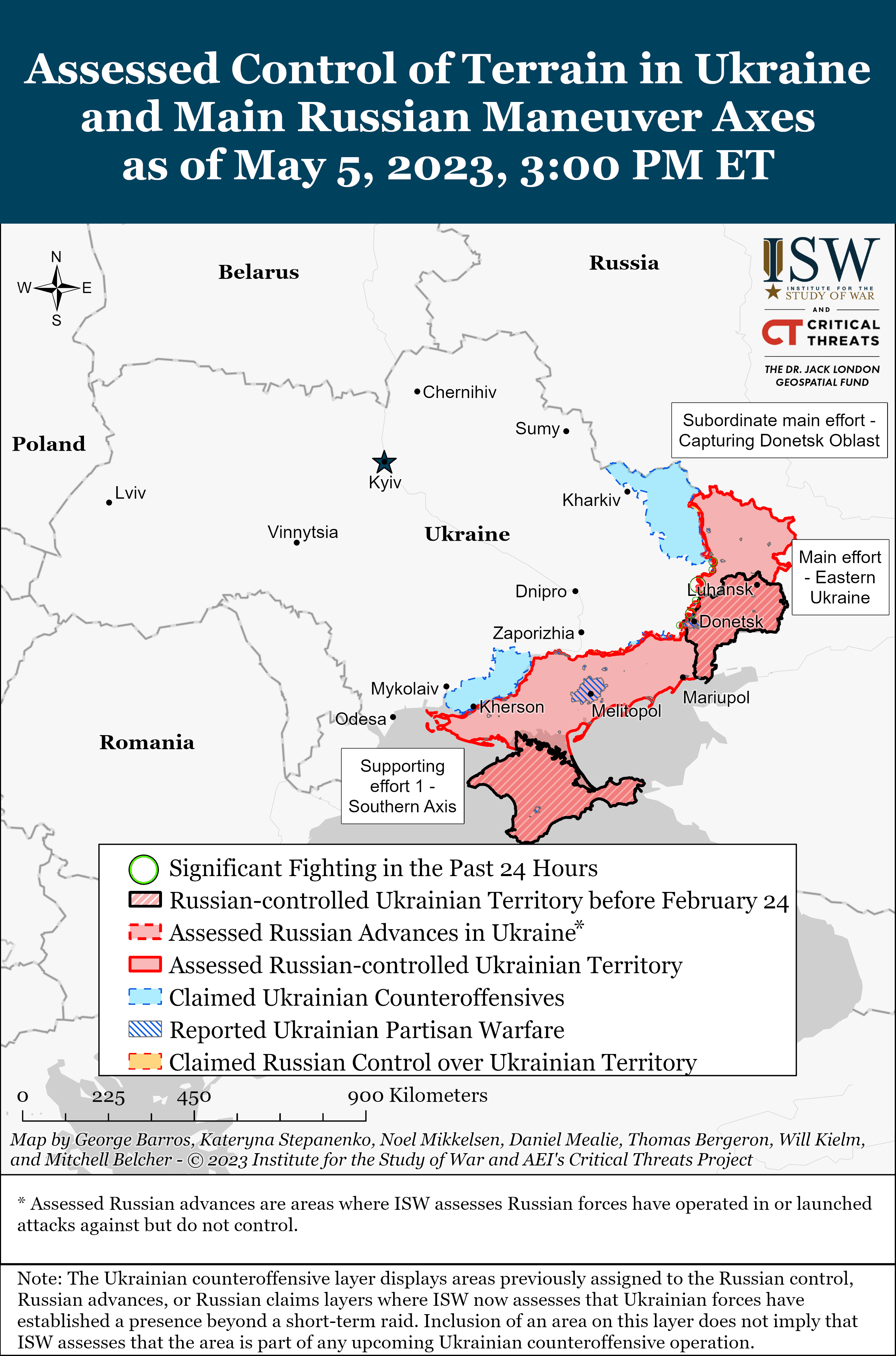
We do not report in detail on Russian war crimes because these activities are well-covered in Western media and do not directly affect the military operations we are assessing and forecasting. We will continue to evaluate and report on the effects of these criminal activities on the Ukrainian military and the Ukrainian population and specifically on combat in Ukrainian urban areas. We utterly condemn these Russian violations of the laws of armed conflict, Geneva Conventions, and humanity even though we do not describe them in these reports.
- Russian Main Effort – Eastern Ukraine (comprised of two subordinate main efforts)
- Russian Subordinate Main Effort #1 – Capture the remainder of Luhansk Oblast and push westward into eastern Kharkiv Oblast and encircle northern Donetsk Oblast
- Russian Subordinate Main Effort #2 – Capture the entirety of Donetsk Oblast
- Russian Supporting Effort – Southern Axis
- Russian Mobilization and Force Generation Efforts
- Activities in Russian-occupied areas
Russian Main Effort – Eastern Ukraine
Russian Subordinate Main Effort #1 – Luhansk Oblast (Russian objective: Capture the remainder of Luhansk Oblast and push westward into eastern Kharkiv Oblast and northern Donetsk Oblast)
Russian forces conducted limited ground attacks along the Svatove-Kreminna line on May 5. The Ukrainian General Staff reported that Russian forces conducted unsuccessful offensive operations near Bilohorivka (10km south of Kreminna) and Spirne (25km south of Kreminna).[21] Ukrainian Severodonetsk Raion Military Administration Head Roman Vlasenko reported ongoing fighting near the Kreminna forest area and Bilohorivka.[22] A Russian milblogger claimed on May 4 that Russian forces conducted positional battles near Makiivka (23km northwest of Kreminna) and the Zhuravka gully (18km west of Kreminna).[23] Footage published on May 4 purportedly shows elements of the 88th Brigade (2nd Luhansk People’s Republic Army Corps) operating in the Siversk (17km southwest of Kreminna) direction.[24]
Russian Subordinate Main Effort #2 – Donetsk Oblast (Russian Objective: Capture the entirety of Donetsk Oblast, the claimed territory of Russia’s proxies in Donbas)
Russian forces made additional gains within Bakhmut as of May 5. Geolocated footage published on May 5 shows that Russian forces have advanced in northwestern Bakhmut towards Khromove (directly west of Bakhmut).[25] A Russian milblogger claimed that Russian forces attacked Ukrainian positions east of Novomarkove (12km northwest of Bakhmut), west of Klishchiivka (6km southwest of Bakhmut), and Kurdyumivka (14km southwest of Bakhmut).[26] The Ukrainian General Staff reported continued fighting in Bakhmut, and Ukrainian forces repelled Russian ground attacks near Bohdanivka (6km northwest of Bakhmut), Markove (14km northwest of Bakhmut), Hryhorivka (9km northwest of Bakhmut), Ivanivske (6km west of Bakhmut), and Niu York (30km southwest of Bakhmut).[27] Geolocated imagery posted on May 4 shows a destroyed Ukrainian bridge over the Siverskyi Donets Donbas Canal west of Bakhmut near Chasiv Yar.[28] Russian milbloggers claimed that Ukrainian forces blew up the bridge, but the Russian Ministry of Defense (MoD) claimed that Russian forces struck an unspecified bridge near Chasiv Yar.[29] ISW has not observed signs of a Ukrainian withdrawal from positions east of the Siverskyi Donets Donbas Canal, suggesting that Ukrainian forces retain at least one critical ground line of communication (GLOC) into Bakhmut.
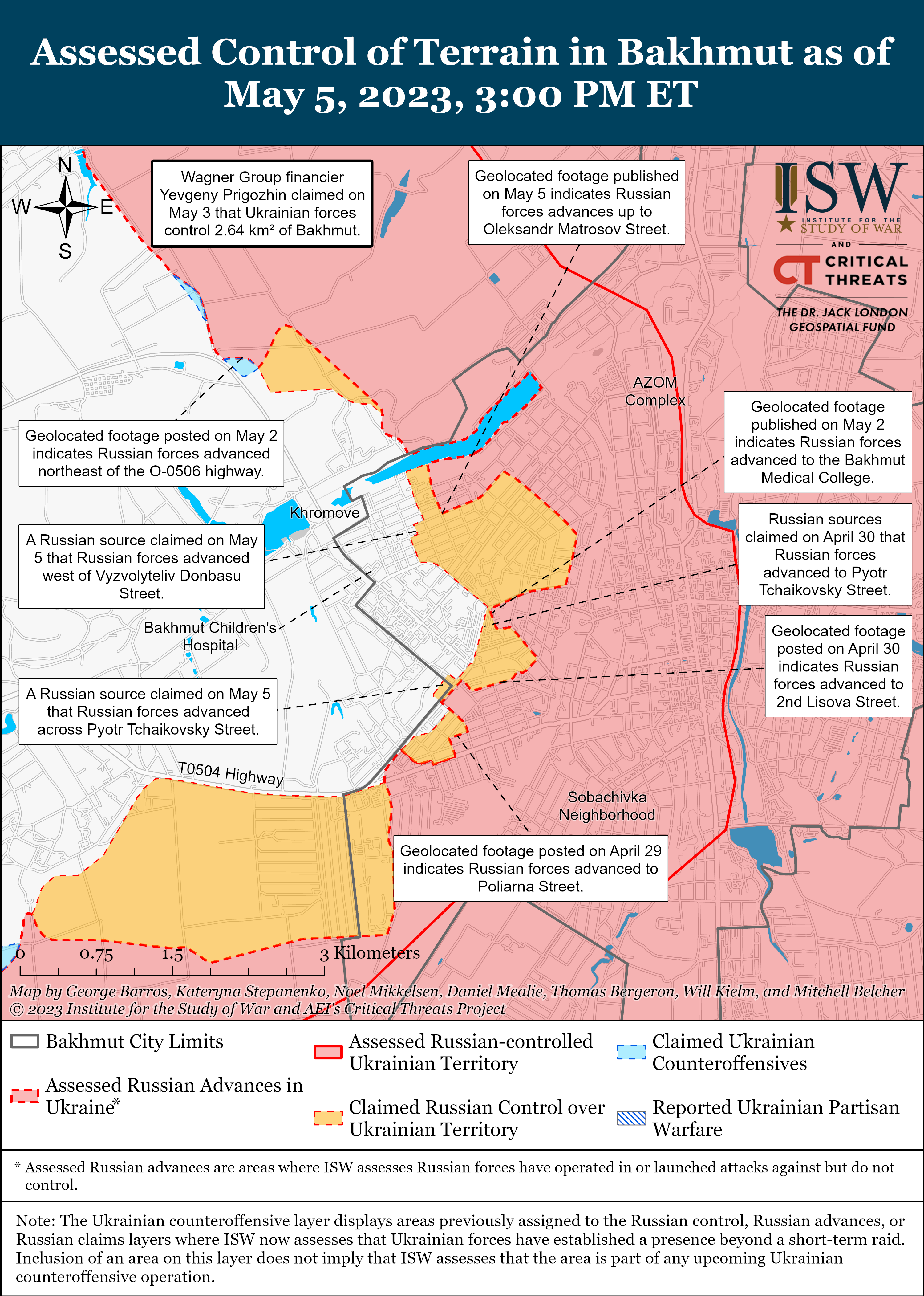
Russian milbloggers claimed that Ukrainian forces conducted limited counterattacks near Bakhmut. The milbloggers claimed that Ukrainian forces conducted counterattacks to constrain Russian positions near Bohdanivka, Hryhorivka, Ivanivske, and Klishchiivka (5km southwest of Bakhmut).[30] ISW has not observed any confirmed Ukrainian counterattacks in these areas and has previously assessed that reports of Ukrainian counterattacks elsewhere in Donetsk Oblast appear to be a part of an ongoing pattern of localized Ukrainian counterattacks.[31] See topline note on terminology.
Russian forces conducted limited ground attacks on the Avdiivka-Donetsk City line on May 5. The Ukrainian General Staff reported that Russian forces conducted unsuccessful offensive operations near Avdiivka and Marinka (27km southwest of Avdiivka).[32] A Russian milblogger claimed that Russian forces conducted unsuccessful ground attacks near Novomykhailvika (36km southwest of Avdiivka).[33]
Russian forces did not conduct any confirmed or claimed ground attacks in western Donetsk Oblast on May 5.[34] Ardent nationalist and former Russian officer Igor Girkin claimed that Ukrainian forces pushed Russian forces from positions west of Mykilske (27km southwest of Donetsk City) to the outskirts of the settlement during limited counterattacks on May 4, though ISW is unable to confirm this claim.[35]
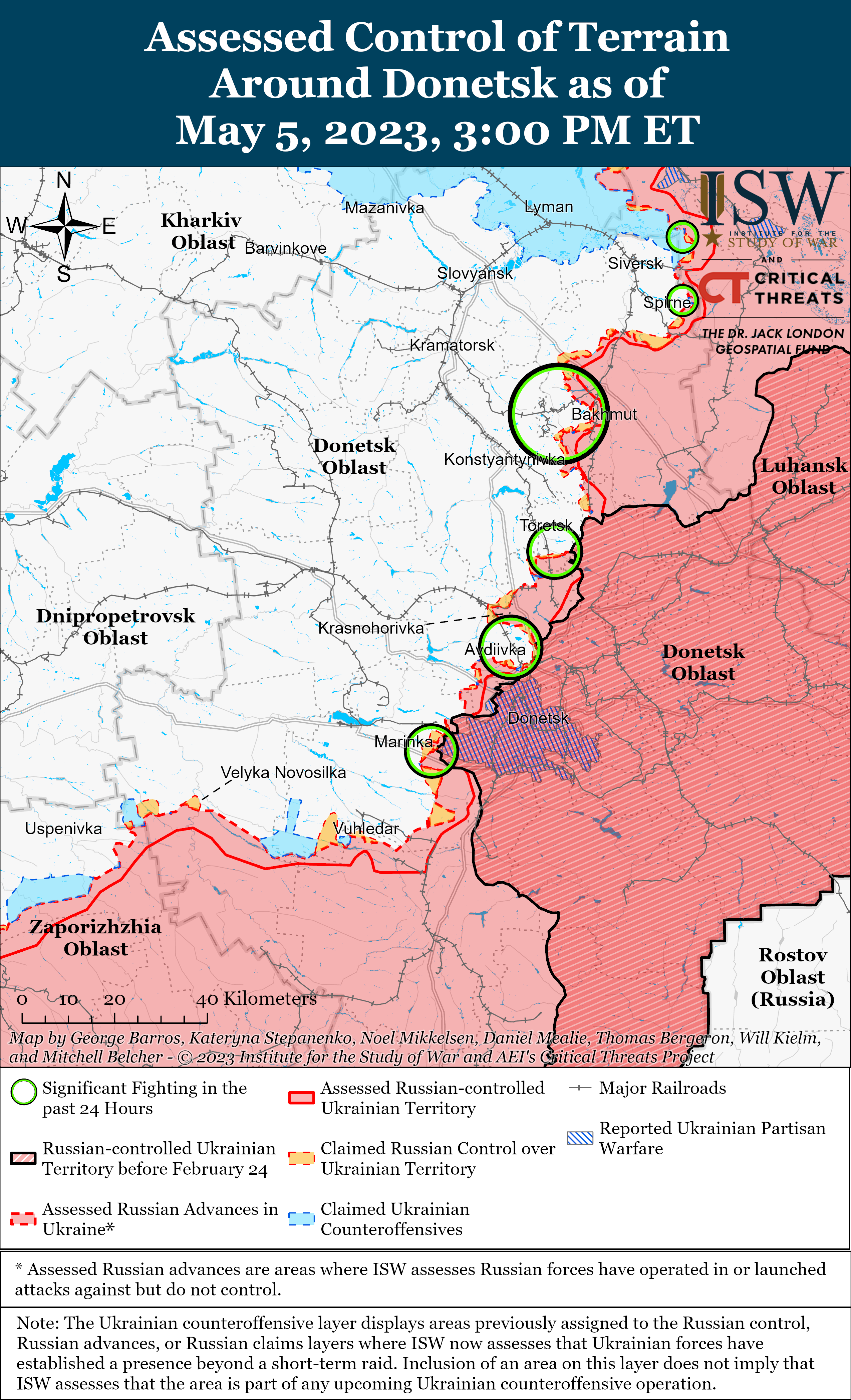
Russian Supporting Effort – Southern Axis (Russian objective: Maintain frontline positions and secure rear areas against Ukrainian strikes)
The Russian Federal Security Service (FSB) claimed that it prevented a Ukrainian assassination attempt against an occupation deputy of the Zaporizhzhia Nuclear Power Plant (ZNPP) on May 5.[36] The FSB claimed that its operatives stopped two agents of Ukraine’s Main Intelligence Directorate (GUR) before they were able to attack an unnamed member of the ZNPP’s occupation leadership board.[37] The FSB likely made these claims in order to obfuscate a May 3 report from the Ukrainian State Nuclear Regulatory Inspectorate that the International Atomic Energy Agency (IAEA) personnel at the ZNPP found that Russian forces placed military weapons, equipment, and explosives in the turbine room of the ZNPP’s Reactor No. 4.[38]
Russian sources claimed that Russian air defense shot down a drone over the Belbek Airfield in Sevastopol, occupied Crimea, on the night of May 4. [39] Satellite imagery posted between April 9 and May 4 shows that Russia has lost at least three oil storage tanks at the Sevastopol oil terminal.[40]
Russian forces continued artillery fire along the line of contact in southern Ukraine on May 5.[41]
Russian Mobilization and Force Generation Efforts (Russian objective: Expand combat power without conducting general mobilization)
Chechen Republic Head Ramzan Kadyrov continues his own personal force generation efforts aimed at securing Russian President Vladimir Putin’s favor. Kadyrov posted footage on May 4 purporting to show another group of volunteers who trained at the Special Forces University in Gudermes, Chechnya deploying to Ukraine.[42] The Russian Ministry of Defense (MoD) has recently excluded Chechnya from the list of regions where additional guarantees and compensations for servicemen are provided.[43] Kadyrov may have agreed to the exclusion of Chechnya from additional benefits to decrease the recruitment cost of Kadyrov’s parallel military structures for the MoD. Putin likely pressured Kadyrov during a March 13 meeting to increase the role of Chechen fighters in combat operations in Ukraine, and Kadyrov appears to be using Chechnya’s role in the Russian military sphere to launch a renewed campaign to regain national attention.[44] Kadyrov met with representatives of the National Research Center “Kurchatov Institute” on May 4 to discuss Chechen contributions to Russia’s defense industrial base (DIB).[45]
Activities in Russian-occupied areas (Russian objective: Consolidate administrative control of annexed areas; forcibly integrate Ukrainian civilians into Russian sociocultural, economic, military, and governance systems)
Russian occupation authorities continue measures to strengthen social control of occupied territories. Zaporizhia Oblast occupation head Yevgeny Balitsky signed a decree on May 4 banning the sale of hard liquor in retail stores throughout occupied Zaporizhia Oblast from May 5 to August 3, 2023.[46] Balitsky warned that individuals and enterprises violating the ban will face fines ranging from 20,000 to 300,000 rubles (about $258 and $3,875, respectively) and that the only exceptions to the ban are retail sales of beer, cider, and mead.[47] Balitsky’s anti-alcohol measures closely mirror similar efforts in the Soviet Union, which sought to improve the health and productivity of Soviet citizens, as well as tighten control of the public.
Occupied Kherson Oblast Ministry of Health continues the medical examinations of Ukrainian children in occupied Kherson Oblast, likely to facilitate the deportation of Ukrainian children to Russia under the guise of rehabilitation.[48] Occupied Kherson Oblast Ministry of Health stated on May 4 that doctors arrived from the Adygea Republic to support examinations on 4,336 Ukrainian children through the end of May.[49] The occupation Ministry of Health stated that Russian doctors from Tver Oblast and occupied Crimea will also travel to occupied Kherson Oblast to assist in the examination effort.
Significant activity in Belarus (ISW assesses that a Russian or Belarusian attack into northern Ukraine in early 2023 is extraordinarily unlikely and has thus restructured this section of the update. It will no longer include counter-indicators for such an offensive.)
ISW will continue to report daily observed Russian and Belarusian military activity in Belarus, but these are not indicators that Russian and Belarusian forces are preparing for an imminent attack on Ukraine from Belarus. ISW will revise this text and its assessment if it observes any unambiguous indicators that Russia or Belarus is preparing to attack northern Ukraine.
The Belarusian Ministry of Defense stated on May 5 that Russian and Belarusian Air and Defense forces conducted joint patrols in Belarusian airspace as part of an ongoing combat readiness check.[50]
Note: ISW does not receive any classified material from any source, uses only publicly available information, and draws extensively on Russian, Ukrainian, and Western reporting and social media as well as commercially available satellite imagery and other geospatial data as the basis for these reports. References to all sources used are provided in the endnotes of each update.
[1] https://t.me/concordgroup_official/896; https://t.me/concordgroup_official/900; https://t.me/concordgroup_official/895
[2] https://www.understandingwar.org/backgrounder/russian-offensive-campaign-assessment-april-23-2023
[3] https://www.understandingwar.org/backgrounder/russian-offensive-campaign-assessment-april-23-2023
[8] https://isw.pub/UkrWar042923 ; https://isw.pub/UkrWar050123 ; https://www.understandingwar.org/backgrounder/russian-offensive-campaign-assessment-april-30-2023
[9] https://t.me/mod_russia/26197; https://meduza dot io/news/2023/05/05/shoygu-poruchil-derzhat-na-osobom-kontrole-postavki-boepripasov-posle-togo-kak-prigozhin-zapisal-videoobraschenie-gde-krichit-na-nego-matom; https://t.me/mod_russia/26198
[10] https://t.me/readovkanews/58209; https://t.me/notes_veterans/9303; https://t.me/milinfolive/100217; https://t.me/bazabazon/17409; https://t.me/astrapress/26231; https://www.kommersant dot ru/doc/5976595; https://t.me/milinfolive/100229; https://t.me/astrapress/26243
[11] https://www.kommersant dot ru/doc/5976595; https://t.me/milinfolive/100229; https://t.me/astrapress/26243
[12] https://understandingwar.org/backgrounder/russian-offensive-campaign-assessment-october-22; https://www.understandingwar.org/backgrounder/russian-offensive-campaign-assessment-october-21; https://www.understandingwar.org/backgrounder/russian-offensive-campaign-assessment-november-16; https://www.understandingwar.org/backgrounder/russian-offensive-campaign-assessment-november-5
[13] https://t.me/sotaproject/58357 ; https://www.kommersant dot ru/doc/5976548 ;https://www.pnp dot ru/social/mvd-predlagaet-vzyat-migrantov-pod-administrativnyy-nadzor.html ; https://regulation.gov dot ru/projects#npa=138054
[14] https://regulation.gov dot ru/projects#npa=138054 ; https://t.me/sotaproject/58357
[15] https://www.pnp dot ru/social/mvd-predlagaet-vzyat-migrantov-pod-administrativnyy-nadzor.html ; https://regulation.gov dot ru/projects#npa=138054
[16] https://kursdela dot biz/news/2023-04-12/ubiystvo-shkolnika-kak-inostrantsy-uchatsya-v-chelyabinske-bez-znaniya-russkogo-2900732; https://www.interfax dot ru/russia/895222
[19] https://tass dot ru/obschestvo/17682485; https://t.me/readovkanews/58185
[20] https://www.understandingwar.org/backgrounder/russian-offensive-campaign-assessment-april-18-2023; https://understandingwar.org/backgrounder/russian-offensive-campaign-assessment-april-12-2023; https://www.understandingwar.org/backgrounder/russian-offensive-campaign-assessment-april-10-2023; https://www.understandingwar.org/backgrounder/russian-offensive-campaign-assessment-april-8-2023; https://www.understandingwar.org/backgrounder/russian-offensive-campaign-assessment-april-2-2023; https://www.understandingwar.org/backgrounder/russian-offensive-campaign-assessment-march-15-2023
[21] https://www.facebook.com/GeneralStaff.ua/posts/pfbid0qkvWT9i9wK2Shv6hDqnHY8ECjJYTDzZtSoBfEYMYP9okSAWmwfoExbac7V6jZ3BUl
[25] https://twitter.com/SerDer_Daniels/status/1654486039774330883; https://twitter.com/SerDer_Daniels/status/1654493927360065540; https://twitter.com/neonhandrail/status/1654490165384032257
[26] https://t.me/boris_rozhin/84808; https://t.me/wargonzo/12314
[27] https://www.facebook.com/GeneralStaff.ua/posts/pfbid0qkvWT9i9wK2Shv6hDqnHY8ECjJYTDzZtSoBfEYMYP9okSAWmwfoExbac7V6jZ3BUl; https://www.facebook.com/GeneralStaff.ua/posts/pfbid02fQp6UGYR7agqX25eRk9s4Fc68MQNUsUowqJGLeevcgiHBM2zaEhyc6XRiTpam9izl
[28] https://t.me/vrogov/9211; https://t.me/voenkorKotenok/47305; https://twitter.com/markito0171/status/1654406722172203008; https://twitter.com/foosint/status/1654416355058151424; https://twitter.com/Militarylandnet/status/1654443403952660482?s=20; https://t.me/sashakots/39641; https://t.me/mod_russia/26193
[29] https://t.me/vrogov/9211; https://t.me/voenkorKotenok/47305; https://twitter.com/markito0171/status/1654406722172203008; https://twitter.com/foosint/status/1654416355058151424
[30] https://t.me/boris_rozhin/84808; https://t.me/wargonzo/12314
[32] https://www.facebook.com/GeneralStaff.ua/posts/pfbid0qkvWT9i9wK2Shv6hDqnHY8ECjJYTDzZtSoBfEYMYP9okSAWmwfoExbac7V6jZ3BUl; https://www.facebook.com/GeneralStaff.ua/posts/pfbid02fQp6UGYR7agqX25eRk9s4Fc68MQNUsUowqJGLeevcgiHBM2zaEhyc6XRiTpam9izl
[33] https://t.me/wargonzo/12314
[34] https://www.facebook.com/GeneralStaff.ua/posts/pfbid0qkvWT9i9wK2Shv6hDqnHY8ECjJYTDzZtSoBfEYMYP9okSAWmwfoExbac7V6jZ3BUl; https://www.facebook.com/GeneralStaff.ua/posts/pfbid02fQp6UGYR7agqX25eRk9s4Fc68MQNUsUowqJGLeevcgiHBM2zaEhyc6XRiTpam9izl
[35] https://www.facebook.com/GeneralStaff.ua/posts/pfbid0qkvWT9i9wK2Shv6hDqnHY8ECjJYTDzZtSoBfEYMYP9okSAWmwfoExbac7V6jZ3BUl; https://www.facebook.com/GeneralStaff.ua/posts/pfbid02fQp6UGYR7agqX25eRk9s4Fc68MQNUsUowqJGLeevcgiHBM2zaEhyc6XRiTpam9izl
[36] https://t.me/readovkanews/58202 ; https://t.me/rybar/46638 ; https://t.me/boris_rozhin/84784; https://t.me/notes_veterans/9301; https://t.me/russkiy_opolchenec/36497
[37] https://t.me/readovkanews/58202 ; https://t.me/rybar/46638 ; https://t.me/boris_rozhin/84784; https://t.me/notes_veterans/9301; https://t.me/russkiy_opolchenec/36497
[38] https://snriu.gov dot ua/en/news/russian-occupants-located-military-equipment-and-explosives-in-the-turbine-room-of-znpp-unit-4
[39] https://t.me/boris_rozhin/84700; https://t.me/basurin_e/1253; https://t.me/razvozhaev/2700 ; https://t.me/boris_rozhin/84800; https://t.me/epoddubny/15839
[40] https://twitter.com/IntelCrab/status/1654162786061099008?s=20
[41] https://www.facebook.com/GeneralStaff.ua/posts/pfbid02fQp6UGYR7agqX25eRk9s4Fc68MQNUsUowqJGLeevcgiHBM2zaEhyc6XRiTpam9izl; https://www.facebook.com/GeneralStaff.ua/posts/pfbid0qkvWT9i9wK2Shv6hDqnHY8ECjJYTDzZtSoBfEYMYP9okSAWmwfoExbac7V6jZ3BUl; https://t.me/mod_russia/26194; https://t.me/boris_rozhin/84718
[42] https://t.me/RKadyrov_95/3595
[43] https://t.me/sotaproject/58262; https://regulation.gov dot ru/projects#npa=137996
[45] https://t.me/RKadyrov_95/3597
